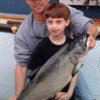The U.S. Department of Agriculture is again working with the Michigan Department of Natural Resources, this time to control an explosion of cormorants nesting on islands in and around Lake Huron's Thunder Bay. The explosion of nesting pairs of cormorants is not something the locals or the DNR want to have hanging around their resurging populations of yellow perch and walleyes. Due in large part to the collapse of alewives, Michigan biologists at the annual lake committee meetings of the Great Lakes Fishery Commission stated Thunder Bay has recently seen an upsurge in predation on yellow perch and young walleye. Up in the Les Cheneaux Islands, about 16,000 cormorants preyed on alewives and perch. DNR officials want to act quickly before their rebounding Thunder Bay perch and walleye populations meet the same fate. Citing public concerns for declining sports fish populations, lower tourism and environmentally decimated shorelines received at a series of statewide hearings, House members submitted a letter to DNR Director Rebecca Humphries seeking details on cormorant management programs during the past few years. “It was very apparent at the hearings that cormorants are having an extremely negative impact on Michigan,†said state Rep. Howard Walker, R-Traverse City. “These ongoing problems need to be addressed to protect the environment and communities that rely on the same resources as the bird, yet there appears to be little being done.†The letter also asked the DNR to implement more controls on the birds or provide reasons why more controls cannot be imposed. “Although we've seen some successes in the Alpena and Les Cheneaux Island areas working with the USDA Wildlife Services, more needs to be done,†Gillard aid. “I am hopeful we can continue and expand these efforts to reduce the cormorant population to truly have an impact on the problem.â€


